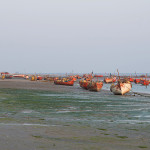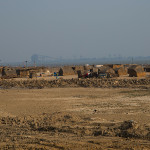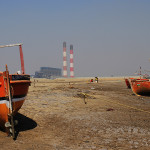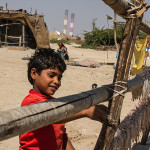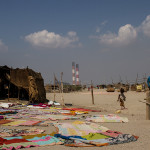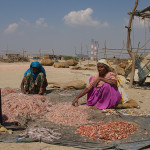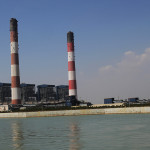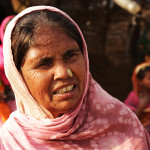A view of the Tata Mundra Ultra Mega Power Project (UMPP) Site. Original image by Joe Athialy
The 4,000-megawatt Tata Mundra power plant that is being developed in Gujarat, India poses numerous environmental and social concerns, including deterioration of water quality and fish populations, displacement of fishermen, community health impacts due to air emissions, and destruction of natural habitats.
Total Cost: US$4,140 million
The Tata Mundra Project is a 4,000-megawatt power plant that is being developed by Coastal Gujarat Power Limited at the port city of Mundra in India’s Gujarat state. This ultra mega project will establish India’s first 800-megawatt unit supercritical technology thermal power plant, which is likely to be the most energy-efficient, coal-based thermal power plant in the country. Imported coal from Indonesia will be used for the project. A consortium of banks including the IFC with a loan up to $450 million and $50 in equity are participating in the financing of this project which costs US $ 4.14 billion.
The project will trigger the IFC’s performance standards(PS) on Social and Environmental Assessment and Management System(PS1), Labor and Working Conditions(PS2), Pollution Prevention and Abatement(PS3), Community Health, Safety and Security(PS4); Land Acquisition and Involuntary Resettlement (PS5); Biodiversity Conservation and Sustainable Natural Resource Management(PS6) and Cultural Heritage(PS8). The CAO complaint can be found here (CAO website).
Major concerns: Though the project is a Category A project according to IFC’s environmental and social review procedure it is difficult to say that the procedures during implementation have been duly followed. Environmental concerns:
- Ecologically sensitive area: The project area is on the coastal plain of the Gulf of Kutch and remote from major towns and such sensitive spots as national parks; wildlife sanctuaries; biosphere reserves. The area has mangroves, intertidal mudflats, creeks and estuaries and grasslands. Each of the ecosystems in this region is deeply connected with the fishing, salt panning, agriculture and grazing-related livelihoods of the people living here.
- Disposal of wastes: Waste disposal in sea would mean danger to marine life. Mangroves and certain aquatic species would be affected. This would also affect salt panning and fishing activities. The quality of water around industrial and urban center would be degraded. This would directly affect the labour force who generally resides within the vicinity of the industry as has been the experience in India during other projects.
- Greenhouse Gases emission and Carbon trading: Based on Ernst and Young, the estimated baseline CO2 emissions and reductions for the Project would be 30.796 million tons per year (baseline value) and 29.293 million tons per year which would make it India’s third largest emitter of green house gases.
- Since the plant uses supercritical technology; it has been made eligible for carbon credits under Clean Development funds. The ulterior motives become hard not to see. Shakuntala Makhijani and Daphne Wysham in their paper point that Tata in spite of being the one of the world’s wealthiest corporation is able to capture carbon emissions as long as they are captured in a poor country regardless of how rich it is. World Bank is both shaping and investing in this bizarre logic of carbon market where it can arrange carbon credits for low prices, far lower than what the country would have to pay if it made those cuts at home.
Social Concerns:
- Livelihood: Historical and cultural sites; defense installations; and places of historical, religious, or cultural importance are in and around the area. The surrounding areas within a 10 km radius have several rural communities. The villages nearest to the project site boundaries are Tunda, Wandh, Kandagara, and Nana Bhadiya. Most of them being cattle rearing communities (gauchar), fishing communities have lost both their livelihoods and access to livelihoods.
- Land acquisition: Almost 1052 ha of land are to be acquired for the project which comprises of Government/ wasteland, government/grazing land, forest and private land. This would also mean loss of structures and assets as well. Giving people a chance of free and fair acquisition process as laid down procedurally is not something the Indian government or the corporate can boast of.
- Importing coal: It seems bizarre that coal is being imported from Indonesia considering India has its own huge supply of coal. The justification given is that the coal being imported is green coal and critical to supercritical technology. On the other hand the one cannot but notice incoherent and open manipulation coal regulations in Indonesia giving often corrupt local officials control over the resource wealth.
- Funding Thermal Power Projects: It is also strange that India has a huge potential for solar energy yet the IFC is funding thermal projects in spite of its commitment to climate change. Though the project can boast of supercritical technology, there has been no effort made to either research or exploit renewable energy.
Letters and Press Releases
Press statement: World Bank Group Ombudsman to probe Tata Mundra project , July 7, 2011 (BIC website)Local Gujarati group sends letter to Dr. Kim urging withdrawal from Tata Mundra, November 18, 2012 (BIC website)
Over 100 Indian organisations’ letter to World Bank President, November 4, 2013 (BIC website)
International organisations’ letter to World Bank President, November 7, 2013 (BIC website)
Religious leaders write to Dr. Kim, December 6, 2013 (BIC website)
Tata Mundra Lawsuit
Class Action Lawsuit against the IFC on Tata Mundra, April 23, 2015Tata Mundra Lawsuit Client Summaries, April 23, 2015
Tata Mundra Lawsuit Fact Sheet, April 23, 2015
Joint Press Statement on the Lawsuit, April 23, 2015
EarthRights International Press Statement on the Lawsuit, April 23, 2015
CAO Complaint
CAO complaint, June 14, 2011 (CAO website)CAO Audit Report, August 22, 2013 (CAO website)
IFC response to CAO Audit Report, September 12, 2013 (CAO website)
CAO Monitoring Report of IFC’s Response to CAO Audit, January 14, 2015 (CAO website)
IFC response to CAO Monitoring Report, January 20, 2015 (CAO website)
Responses to the CAO Complaint
MASS’ response to IFC’s response, October 24, 2013IFC Statement and Action Plan, November 25, 2013 (CAO website)
MASS’s response to IFC statement, November 28, 2013
President Kim Responds to Civil Society’s Concerns on Private Sector Investments, December 9, 2013 (World Bank website)
MASS’ response to President Kim , December 14, 2013 (MASS’ website)
Compliance Review Panel Report and Responses
Compliance Review Panel Report, March 9, 2015 (CAO website)MASS press release on the CRP report, April 9, 2014 (MASS’ website)
Other
The Real Cost of Power, CSO Fact-Finding Report, June 2012 (BIC website)Activist Q&A: Meet Soumya Dutta, August 8, 2013 (BIC website)
The CGPL Power Plant ‘Tata Mundra’, An Explorative Study of the Impact on Children, 2015 (BIC website)




